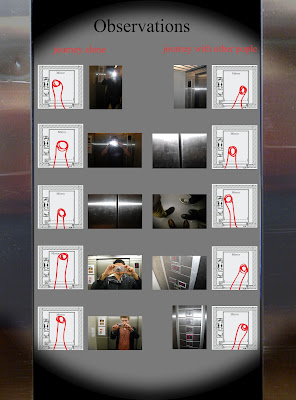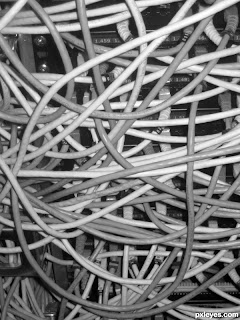Benni
Otting CCDN 231 – assignment 3
300156583
In the
first two parts of the project I focused strongly on special interaction and
how manipulating senses can change the way we interact with space; following
the idea that spatial interactions are a common social as well as private
everyday experience. I followed the idea of creating a more austere way of experiencing
a space by stripping back the senses. I thought it would be most interesting
focus primarily on sight and how manipulating this sense would affect special
interaction as sight is the most dominant sense, “Sight is without doubt our
most dominant sense, yielding nine-tenths of our knowledge of the external
world” (Pocock, 1981) . Experimenting with
the most dominant sense, in a situation where it is strongly rely on would
prove to be an interesting test of senses and instinctual perception.
I
thought it was important to look at this spatial interaction as it is a common
everyday activity and there are very prominent social issues with this small
interaction of space and such interaction are a way of life. “we are spatial
beings, live, and meet each other in space. Space never is meaningless; it always
surrounds us; it is our habitat” (Hornecker, 2005) .
The way we experience a space revolves around what we see and how we
move within the space. I wanted to change the way a space is experienced by
linking these two senses. My experience cut of peripheral vision, leaving the
user with a very little line of sight. This meant that what you could see was
focused on much more and to look around the whole head must be moved not just
eyes. This helmet that caused this was also connected to the user’s body.
Therefore to look around a space the user must move their whole body to move
this small amount of vision they have to experience the space and focus on
different parts of the space.
Peripheral
vision is very important when it comes to interpreting three-dimensional space,
which is why I focused on blocking the peripheral vision to create the
experience. “Peripheral vision can be used to describe perceived spatial/
temporal discontinuities in real-world situations.” (Shapiro,
2010) .
Arthur Shapiro also talks about many peripheral experiments on how peripheral and
central visions interpret space differently, particularly motion. Peripheral
vision is fundamental to interpreting three-dimensional surroundings, however “lacks
the central visual system’s ability to integrate features” (Shapiro,
2010) .
Focusing on this idea, helped me create my experiment where the ability to interpret
the space was taken away, while the ability to focus on specific details within
the space became more prominent.
I wanted
to see how a spatial context can stimulate your senses through the way you
interact with it. How focusing on these small details creates a new context to
the space you are in and changes the way we experience it and stimulates the
senses. The experience focuses on experiencing smaller details of a space,
rather than the simple physical environment of the space which is normally
experienced. This in a way creates a new sensory environment. C. Pamela Graves talks
about the sensory environment created by the detail within churches and the
relationship with the physical form of the church, where these details are what
stimulate the senses and create a spatial experience. “The concept of sensory
environment should be particularly useful when it comes to analysing, in a more
anthropological sense, the relationship between physical form and decoration of
churches.” (Graves, 2007) . This relates back
to my experiment as it focuses on the smaller details of the space, and how
these affect the experience of the physical space itself.
I also wanted
to look at how merging senses affected the experience. The movement of the body
in the experiment isn’t necessarily touch perhaps the sense of instincts, how
you feel you should move your body and move around the space to avoid walking
into anything. The combination of this and the limited sight is what created the
experience. Marc O. Ernst and Heinrich
H. Bultoff looked into the merging of
senses. “With seemingly no effort, the human brain reconstructs the environment
from the incoming stream of often ambiguous sensory information and generates
unambiguous interpretations of the world. To do so many different sources of
sensory information are constantly processed, analysed and combined”. (lthoff, 2004) This links back to
my experiment, where two senses are combined to create a new view of the space
and the way it is interpreted using the sensory information gained from both.
The
experiment was an attempt at creating a more austere way of experiencing a
space. Austere referring to simple and more refined. Through dimming the senses
an austere realism is created. A simpler version of what is there can be seen and
interpreted, while small aspects become more prominent and significant. Spaces
can be too large to comprehend as a whole, therefore being forced to focus on
small points both with body and eyes; it is easier to comprehend the space in
small parts. By focusing on single points, which are determined in the way you
move your body, what you look at becomes more significant. As to focus on a
point and look at it you are using your whole body to look at is, turning the
visual aspect of experiencing a space into a physical experience as well. Rather
than freely roaming throughout a space, every movement is thought of as you
have a largely reduced line of vision which can only moved by the way you move
your body through the space. This was to make the user experience a new way of
special interaction by thinking more about what they are looking at within the
space and how they move throughout it. Focusing on specific things can make you
experience something in an entirely new way. What is seen is an austere version
of what the space is, rather than looking at the space as a whole, focusing on
small refined parts and experiencing them individually.
I feel
the experiment successfully created the mood of austerity through dimming down
the senses to create a different way of experiencing three-dimensional space.
The lack of peripheral vision and connection with the body made everything you
focus on more significant and therefore focus on the small details of the space
more so than you normally would, backing up the mood of austerity “Less is more”
– Mies Van Der Rohe.
Graves, C. P. (2007). Sensing and Believing: Exploring
Worlds of Difference in Pre-Modern England: A Contribution to the Debate Opened
by Kate Giles. World Archaeology.
Hornecker, E. (2005). Space and Place.
University of Sussex Falmer, Brighton.
lthoff, M. O. (2004). Merging the senses into a robust
perception. TRENDS in Cognitive Sciences Vol.8 No.4.
Pocock, D. C. (1981). Sight and Knowledge Vol. 6, No.
4. Transactions of the Institute of British Geographers, 385.
Shapiro, A. (2010). Transitions between Central and
Peripheral Vision Create, volume 5, issue 10. Open Access.































